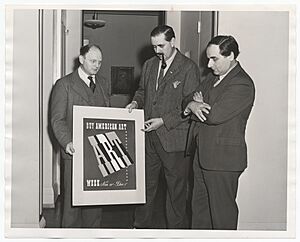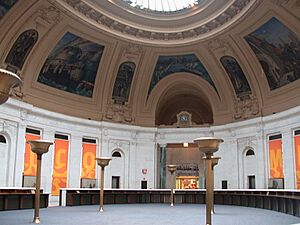Reginald Marsh (artist) facts for kids
Quick facts for kids
Reginald Marsh
|
|
|---|---|

Reginald Marsh (at left), Louis Bouche, and William Zorach
|
|
| Born | March 14, 1898 |
| Died | July 3, 1954 (aged 56) |
| Nationality | American |
| Known for | Painter |
|
Notable work
|
Breadline (1930) Girl on Merry Go Round (1946) Pip and Flip (1932) Tattoo Haircut-Shave (1932) Why Not Use the 'L'? (1930) |
| Movement | Social realism |
Reginald Marsh (born March 14, 1898 – died July 3, 1954) was an American painter. He was born in Paris, France. Marsh is best known for his paintings of everyday life in New York City during the 1920s and 1930s.
His art often showed busy scenes at Coney Island beaches. He also painted popular shows, women, and men without jobs on the Bowery. Marsh used different art materials. He painted with egg tempera and oils. He also made many watercolors, ink drawings, and prints.
Contents
Reginald Marsh's Life Story
Early Life and School
Reginald Marsh was born in Paris, above a cafe. His parents were both American artists. His mother, Alice Randall Marsh, painted small pictures. His father, Frederick Dana Marsh, painted large murals. He was one of the first American artists to show modern factories.
Marsh's family was wealthy. His grandfather made a lot of money in the meat business. When Marsh was two, his family moved to Nutley, New Jersey. They lived in a studio home in an artists' area. The family spent most summers at their home in Woodstock, New York.
Marsh went to the Lawrenceville School. He graduated from Yale University in 1920. At the Yale Art School, he was a top illustrator and cartoonist. He worked for the school's humor magazine, The Yale Record. Marsh really enjoyed his time at Yale.
After college, he moved to New York. He wanted to be a freelance illustrator. In 1922, he drew vaudeville and burlesque performers for the New York Daily News. When The New Yorker magazine started in 1925, Marsh was one of its first cartoonists. He drew for The New Yorker from 1925 to 1944. He also made drawings for New Masses, a journal about social issues.
Art Training and Inspirations
In 1921, Marsh started taking art classes. He went to the Art Students League of New York. His first teacher was John French Sloan. By 1923, Marsh began to paint seriously. That year, he married Betty Burroughs, another art student. They divorced in 1933.
In 1925, Marsh visited Paris again. He loved the city. As a child, he had seen copies of art by Raphael, Leonardo da Vinci, and Michelangelo. But seeing the real paintings at the Louvre museum made him even more interested in these old masters.
While looking at art by European painters like Titian, Tintoretto, and Rubens, Marsh met Thomas Hart Benton. Benton was a social realist and regionalist painter. He also studied the old Baroque masters. Marsh saw how Benton's work was like Tintoretto's. This made Marsh want to paint in a similar way.
After his trip to Europe, Marsh returned to New York. He wanted to use the ideas he saw in Renaissance art. He liked how these artists arranged many figures and buildings into balanced pictures.
Marsh then studied with Kenneth Hayes Miller and George Luks. He started doing fewer commercial jobs. Miller taught Marsh about art design. He told Marsh to focus on his unique sketches of burlesque shows. Miller said, "These awkward things are your work. These are real. Stick to these things!" By the early 1930s, Marsh was fully expressing himself in his art. He continued to show Miller every painting he made.
Later, Marsh worked with John Steuart Curry. Both Marsh and Curry took lessons from Jacques Maroger in 1940. Maroger was a former art restorer at the Louvre. He believed he had found the secrets of the old masters. He taught them about a special painting mix. Marsh and Curry used his ideas in their work.
Reginald Marsh's Art Style
Marsh's first artworks were etchings. In the early 1920s, he also made linocuts. Later, he created lithographs and engravings. He was very careful with his printmaking. He noted the room temperature, how long plates soaked, and the ink used. Marsh loved trying new things in his art. This made his techniques very special.
In the early 1920s, he started working with watercolor and oil paints. He didn't find oil painting easy at first. So, he stuck to watercolor for about ten years. But in 1929, he found egg tempera. He liked it because it was like watercolor but had more depth.
What Marsh Painted
Reginald Marsh did not like modern art. He thought it was boring. Marsh's art style is called social realism. His work showed life during the Great Depression. He painted different social classes. The economic crash made the differences between rich and poor very clear.
Marsh usually painted groups of people. He was interested in the crowd itself, not just individuals. His paintings of crowds were dense and colorful. They remind people of crowds in old movies.
Marsh loved to paint hobos on the Bowery. He also painted crowds on city streets and at Coney Island. Women were another favorite subject. He studied old master paintings. This led him to create art that used classic styles. His work often had religious ideas hidden in it. He based his scenes of human life on the old Baroque masters. He was inspired by the past but painted the present. For example, his painting Fourteenth Street (1934) shows a big crowd in front of a theater. The way they are arranged reminds people of a "Last Judgment" painting.
Marsh filled many sketchbooks with drawings. He drew on the street, in the subway, or at the beach. These sketchbooks were very important to his art. They show his interest in modern details. He drew people, clothes, buildings, and places. He also drew posters and ads. He copied their words and described their colors. In the early 1930s, he started using photography to take notes too.
Signs, newspaper headlines, and ads often appear in Marsh's finished paintings. He used color to show feelings. Bowery scenes were often dull and brown. Sideshow scenes were bright and flashy.
The Bowery
In 1930, Marsh was doing well. He was a successful artist and had inherited money. But he preferred to paint people from the lower classes. He said, "well bred people are no fun to paint." Marsh's Bowery scenes show people facing hard times. His art shows a loss of hope and control. His etching Bread Line—No One Has Starved (1932) shows men in a line. They look still and stuck. The title makes fun of a comment by President Hoover.
Coney Island and Harbors
Marsh loved to go to Coney Island to paint, especially in summer. He showed the strong muscles of his characters. This was like the heroic figures in older European paintings. Marsh said he liked Coney Island because of the sea, fresh air, and crowds. He saw "crowds of people in all directions, in all positions, without clothing, moving—like the great compositions of Michelangelo and Rubens."
Marsh was also drawn to New York's ports. In the 1930s, harbors were very busy. The country needed to recover from the Great Depression. There was a high demand for raw materials. This made big city harbors like New York's very active. Marsh would sketch the seaports. He focused on the tugboats coming in and out. He drew details like masts, bells, sirens, and deck chairs.
New York City Crowds
Just like at Coney Island, Marsh captured the busy crowds of the inner city. Marsh spent a lot of time on sidewalks, in subways, nightclubs, bars, and restaurants. He found his crowds there. He also liked to pick out single people on trains, in parks, or in ballrooms. He wanted to show one person alone in the big city.
Later Life and Legacy
Marsh's art was part of the art contests at the 1932 Summer Olympics and the 1936 Summer Olympics.
In the 1940s, Marsh became an important teacher. He taught at the Art Students League of New York. He ran a summer camp where Roy Lichtenstein was one of his students. Lichtenstein was influenced by Marsh's art subjects. Also in the 1940s, Marsh began drawing for magazines. These included Esquire, Fortune, and Life. His later paintings sometimes showed figures that seemed to float.
Before he died, Marsh received the Gold Medal for Graphic Arts. This award was from the American Academy and the National Institute for Arts and Letters. Reginald Marsh died from a heart attack in Dorset, Vermont, on July 3, 1954.
After he died, many prints and drawings were found. Marsh had kept good records of his work. This made it easy to organize and share his art. Many of his prints are now in the William Benton Museum of Art, the New York Public Library, and the Middendorf Gallery in Washington, D.C.

Selected Artworks
- Why Not Use the L?, Whitney Museum of American Art, 1930
- High Yaller, Private Collection, 1936
- Pip and Flip, Terra Foundation for American Art, 1932
- Tattoo Haircut-Shave, Art Institute of Chicago, 1932
- Locomotives, Jersey City, Smithsonian American Art Museum, 1934
- Woman Walking, Arizona State University Art Museum, 1945
- A Paramount Picture, Collection of Marjorie and Charles Benton, 1934
- Twenty-Cent Movie, Whitney Museum of American Art, 1936
- Coney Island Bathers, Minneapolis Institute of Art, c. 1946
- In the Surf – Coney Island, Collection of Mr & Mrs. Lloyd Goodrich, 1946
- Girl on Merry Go Round, Collection of Mrs. Reginald Marsh, 1946
- Mural cycle in the rotunda of the Alexander Hamilton U.S. Custom House, New York City, 1937
- Savoy Ballroom, Detroit Institute of Arts, 1931
- Breadline, Smithsonian Institution, 1930
- Steeplechase, Collection of Edward Laning, 1954
- The Bowl, The Brooklyn Museum, 1933
- Coney Island (Russia declares war on Japan), Collection of Marjorie and Charles Benton
- Down at Jimmy Kelly's, The Chrysler Museum, 1936
- Jelkye Trial Series, Boca Raton Museum of Art, 1951
Art Shows
- 1938, Solo Exhibition, Frank K.M Rehn Galleries, New York
- 1957, 70 Photographers Look at New York, Museum of Modern Art
- 1997, Reginald Marsh at D.C Moore, New York City
- 2003, April 18 – May 25, New York City Drawings, Seraphin Galleries, Philadelphia
- 2006, February 19 – May 14, Reginald Marsh, Nassau County Museum of Art, New York
- 2013, June 21 – September 1, Swing Time: Reginald Marsh and Thirties New York, New-York Historical Society, New York
Images for kids
-
Sorting the Mail (1936), Mural in the William Jefferson Clinton Federal Building
See Also
- American realism
- Ashcan School
- Social Realism
- American scene painting
- Regionalism (art)



